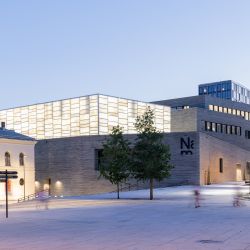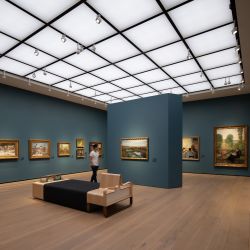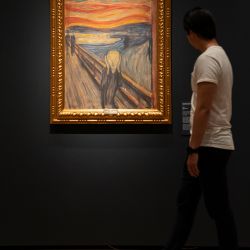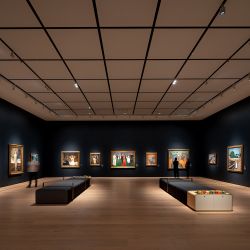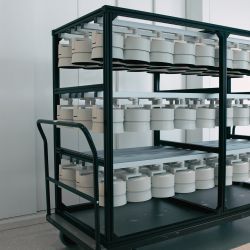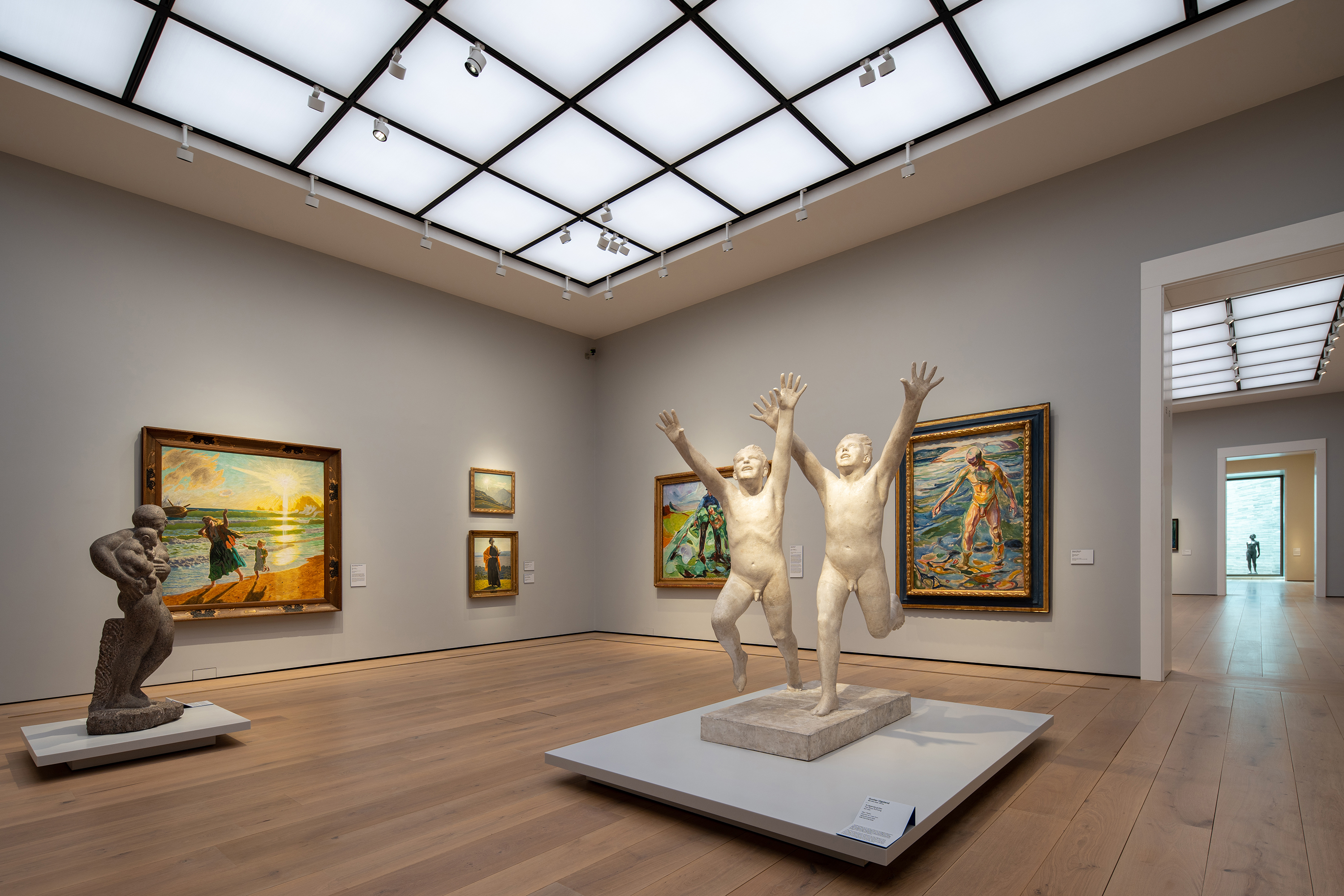
Download this article:
The new National Museum in Oslo: a mammoth 54,600 square-metre project that unites previously dispersed institutions under a single roof. The new building, crowned by a shimmering "light hall", preserves and presents Norway's cultural heritage in all of its variety and complexity. The exhibition lighting with spotlights in the building comes from ERCO, embedded in an intelligent, holistic concept for luminaire logistics that meets the challenges of museum operations of this dimension both now and in the future.
A reclaiming of waterfronts is a global trend in urban development. Oslo has also very successfully converted former traffic and harbour areas on its banks facing the fjord into an attractive cultural district. The 2008 Opera House and the striking Munch Museum are now joined by the timelessly simple building of the Norwegian National Museum of Art, Architecture and Design on the site of the city's former west railway station. The building, composed of reduced cubic volumes, does not renounce its sheer size, and frames the former station building, now accommodating the Nobel Peace Centre, in an L-shape. The granite facade emanates a sense of durability, whilst the "light hall" seemingly supplanted on the roof and with a translucent shell of glass marble laminate sets a shimmering accent in the city panorama at any time of day or night.
This extraordinary space for temporary exhibitions, a key element of the design by the architect Klaus Schuwerk of Kleihues + Schuwerk, clearly demonstrates the importance afforded to light in this project. "Initially there was the exhibition concept. Together with the architects we asked ourselves how we could translate the idea into a building- and space concept. It's really succeeded. The museum experience is significantly determined by the architecture and interior design – in which, of course, the light also makes a significant contribution," says project director Jon Geir Placht. The museum represents a point of crystallisation for the cultural identity of affluent Norway. Quality was thus given absolute priority, and, accordingly, the planners and curators made no compromises regarding exhibition lighting for more than 90 halls. The National Museum now unites four institutions that were previously housed separately: the Norwegian National Gallery, the Museum of Contemporary Art, the Museum of Decorative Arts and Design and the Museum of Architecture, which, however, continues to also occupy its previous location designed by Christian Heinrich Grosch.
High-contrast lighting – flexible and future-proof
“With lighting design, it is possible to create certain narratives and trigger emotions in the observer, it is essential to give meaning to art.” explains Mai Britt Guleng, Senior Curator at The National Museum. The museum placed the exhibition design and lighting in Italian hands: the architects Guicciardini & Magni from Florence worked closely with the experienced lighting designer Massimo Iarussi, whose portfolio includes not only the highlight of the Uffizi Gallery but also many further premium exhibition and museum projects. He succeeded in creating a lighting concept that achieves a fine balance – on the one hand doing justice to the enormous range of different themes, exhibits and media as well as maintaining a sense of suspense with atmospheric contrasts, and on the other, enabling rational installation and operation thanks to flexible, modular technology. "The light merges with the exhibition and guides visitors through the museum. Our aim was to give them a calm, pleasant experience despite the sheer size and quantity of art," explains Massimo Iarussi. "Variation typifies both the exhibition concept and the lighting concept. Through the art, the materials and also the lighting, each room is different from the others."
The universal basis is a ceiling grid made of track. Supplemented with square light ceiling modules from another manufacturer, the impression of a classic hall of skylights is created. Depending on the desired atmosphere in the hall, spotlights and wallwashers are able to highlight individual exhibits almost imperceptibly from the dominant general brightness or carve them out of the darkness with powerful accents. "The light is a metaphor for journeying through time. The exhibition design depicts a chronology that symbolically emphasises the lighting," Iarussi explains. "In the rooms displaying art from antiquity we worked with strong contrasts. Light is very focused on the works to give them more plasticity and presence. Coming towards the contemporary, the lighting becomes increasingly 'democratic': less concentrated and more diffuse. After all, art has been accessible to everyone, to the entire population, since the modern era. The diffuse light symbolises this complete access to art."
This lighting task in the National Museum is performed by approximately 5,700 spotlights and floodlights from the ERCO Parscan range. The product family is ideally suited for diverse and changing applications that require maximum flexibility. This is because Parscan's technical platform with Spherolit lens technology and LEDs with CRI>97 not only features superior efficiency and quality of light, but also an enormous range of wattages and light distributions. The inherent flexibility of track-mounted spotlight systems is further enhanced by tool-free interchangeable lenses for different light distributions. The archetypal and minimalist design of Parscan spotlights forms a design thread throughout the entire museum. "The ERCO solution enabled the widest variance, for example with colour temperature, which can differ from room to room, and through different light distributions. For the high-contrast displays we used narrow spot distribution in dark surroundings. This required maximum-precision optics that project precise beams of light without any light spill," says Massimo Iarussi.
A modified version of Parscan with an extended bracket is used, required due to peripheral steps in the ceiling construction. Such project-specific adaptations are covered by the "ERCO individual" service, creating lighting tools that adapt to the needs of designers and specifications on site.
Transport trolleys as a customised logistics solution
Simply delivering spotlights is not enough in today's close cooperation between clients, lighting designers and suppliers. In addition to the actual products and individual problem solutions, packages increasingly include consulting and services that draw on ERCO's decades of experience in museum lighting. At the National Museum, this went far beyond the supply of the customised spotlights: In collaboration with the museum, ERCO technicians developed compact, customised transport trolleys for smoothly installing the several thousand luminaires in the different halls. The trolleys can stock the spotlights of a particular room on 15 track segments arranged like a shelf and roll them conveniently through the museum. A textile covering protects against dust from construction operations. Because the track is electrified, work such as DALI addressing of the spotlights can be done on site on the floor. "The trolleys mean we can transport a variety of luminaires more easily in the new National Museum, cover long distances quicker and also programme them directly. The trolleys make daily work more efficient and also help in preparing for future exhibitions," explains exhibition technician Magnus Mikaelsen. After the initial installation phase, the trolleys now serve as compact storage modules for the museum's pool of lighting used for temporary exhibitions. Such solutions for optimum lighting quality and smooth luminaire logistics constitute the added value that repeatedly convinces leading museums around the world to work with ERCO.
Link to the film
Link to the trolley film
Project data
Project: The National Museum Oslo, Oslo / Norway
Architecture: Klaus Schuwerk, Naples / Italy, Arge Kleihues + Schuwerk, Berlin / Germany
Lighting design (architecture): Rambøll, Copenhagen / Denmark
Lighting design (exhibition): Massimo Iarussi, Florence / Italy
Exhibition design: Guicciardini & Magni Architetti, Florence / Italy
Photography: Iwan Baan, Amsterdam / the Netherlands, Tomasz Majewski, Oslo / Norway
Products: Parscan
Photo credits: © ERCO GmbH, www.erco.com, Photography: Iwan Baan, Tomasz Majewski
About ERCO
The ERCO Light Factory in the German town of Lüdenscheid is a leading international specialist in architectural lighting using LED technology. The family business, founded in 1934, now operates as a global player with independent sales organisations and partners in 55 countries worldwide. Since 2015, ERCO’s portfolio has been 100% LED. With this in mind, ERCO in Lüdenscheid develops, designs and produces digital luminaires with focus on photometrics, electronics and design. Working closely with architects, lighting designers and engineers, ERCO develops lighting tools used primarily for applications in the following fields: Work and Culture, Community and Public/Outdoor, Contemplation, Living, Shop and Hospitality. ERCO understands digital light as the fourth dimension of architecture – providing highly precise and efficient lighting solutions to support creative designers in turning their visions into reality.
If you require any further information on ERCO or image material, please visit us at press.erco.com/en. We can also provide you with material on projects worldwide for your media coverage.
Relevant image material
© ERCO GmbH, www.erco.com, Photography: Iwan Baan, Tomasz Majewski
© ERCO GmbH, www.erco.com, Photography: Iwan Baan, Tomasz Majewski
© ERCO GmbH, www.erco.com, Photography: Iwan Baan, Tomasz Majewski
© ERCO GmbH, www.erco.com, Photography: Iwan Baan, Tomasz Majewski
© ERCO GmbH, www.erco.com, Photography: Iwan Baan, Tomasz Majewski
© ERCO GmbH, www.erco.com, Photography: Iwan Baan, Tomasz Majewski
© ERCO GmbH, www.erco.com, Photography: Iwan Baan, Tomasz Majewski
